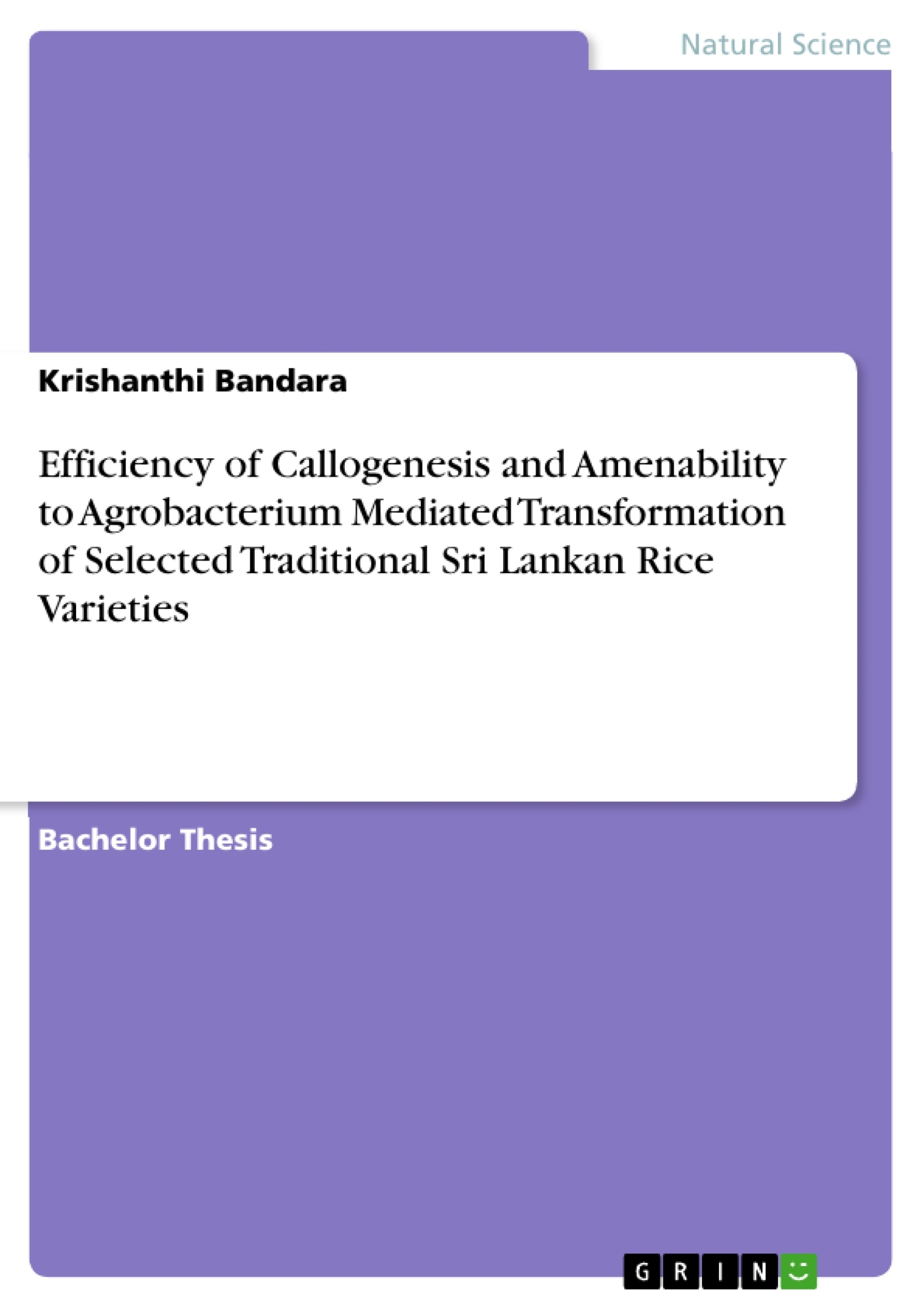Traditional rice varieties consists of many important traits such as medicinal and nutritional value, drought and pest resistance. Efficient tissue culture and transformation techniques are important in uncovering such genes from traditional rice varieties. Aim of this study was to optimize an efficient protocol of callus induction and transformation of Sri Lankan traditional rice varieties.
Dahanala, Kaluheenaty, Kalubalawee, madael, Kahatawalu, Kaharamana, Gonabaru, Alwee, Wannidahanala, Kottiyaran, BG380 and H4 were selected for the study. Twelve different concentration combinations of 2, 4-D and kinetin were used to determine the effect of hormone concentrations on callus induction. Calli were transformed using Agrobacterium mediated transformation. For calli transformation Agrobacterium tumefaciens GV3101 containing pBI121 vector was used. Transformed callus were detected using GUS analysis. Efficiency of transient transformation was calculated for each variety. There was a significant difference of 12 treatments of callus induction of tested varieties except Gonabaru. Kaluheenaty, Madael, Gonabaru, Kottiyaran and H4 have shown the best callus induction for the same hormone concentration combination of 2.5mg/L 2,4-D and 0.5 mg/L kinetin. Other six varieties showed best callus induction for different concentration combinations with majority of them being in the region of 2.5mg/L 2,4-D and 0.5 mg/L kinetin.
Results showed that callus induction was genotype dependant. Higher transient transformation efficiencies were reported for most varieties. Depending on transient transformation efficiency, tested varieties could be divided into significantly different seven groups. Results of this study indicate the possibility of using optimized hormone concentrations and Agrobacterium mediated transformation for genetic transformation of selected Sri Lankan traditional rice varieties.
Inhaltsverzeichnis (Table of Contents)
- CHAPTER 1
- INTRODUCTION
- Background
- Justification
- CHAPTER 2
- LITERATURE REVIEW
- Rice
- Genetic transformation of plants
- Development of rice transformation system
- Suitable rice explants for genetic transformation
- Applications of Agrobacterium mediated transformation of rice
- CHAPTER 3
- MATERIALS AND METHODS
- Plant material
- Culture media
- Vector and bacterial strain
- Callus derivation
- Agrobacterium mediated calli transformation
- Detection of transformants using GUS analysis
- Experimental design and Data Analysis
- CHAPTER 4
- RESULTS
- Callus induction
- Genetic transformation of rice
- CHAPTER 5
- DISCUSSION
- Rice explants for callus formation
- Surface sterilization of seeds before inoculation
- Nutrient media for callus induction
- Callus initiation and growth
- Effect of other minor nutrients on callogenesis
- Efficiency of genetic transformation of callus by Agrobacterium mediated method
- CHAPTER 6
- CONCLUSIONS AND SUGGESTIONS
- Conclusions
- Suggestions
Zielsetzung und Themenschwerpunkte (Objectives and Key Themes)
This report investigates the optimization of callus induction and transformation protocols for selected traditional Sri Lankan rice varieties using Agrobacterium mediated transformation. The study aims to enhance the efficiency of gene transfer and establish a reliable method for unlocking the valuable traits, such as pest resistance and nutritional value, inherent in these traditional varieties.
- Callus induction efficiency and its dependence on genotype.
- Optimal hormone concentrations for callus induction in various rice varieties.
- Evaluation of Agrobacterium-mediated transformation efficiency in diverse traditional rice varieties.
- The potential of Agrobacterium-mediated transformation for genetic modification in Sri Lankan rice varieties.
Zusammenfassung der Kapitel (Chapter Summaries)
Chapter 1 introduces the study's background and justification, highlighting the significance of traditional rice varieties and the potential of genetic transformation techniques for unlocking their inherent traits. Chapter 2 provides a comprehensive literature review, discussing the biology of rice, the principles of genetic transformation, and the development of specific rice transformation systems. Chapter 3 details the materials and methods used, including plant material selection, culture media preparation, vector and bacterial strain information, callus derivation protocols, Agrobacterium-mediated transformation procedures, GUS analysis for detection of transformants, and experimental design and data analysis. Chapter 4 presents the results obtained from the study, focusing on the efficiency of callus induction and the transient transformation efficiencies observed for various rice varieties. Chapter 5 discusses the results, exploring factors influencing callus formation, the importance of surface sterilization, the role of nutrient media, and the impact of genotype on the efficiency of Agrobacterium-mediated transformation. Chapter 6 summarizes the conclusions drawn from the study and proposes future directions for further research in this field.
Schlüsselwörter (Keywords)
The report focuses on the efficiency of callogenesis and the amenability to Agrobacterium-mediated transformation of selected traditional Sri Lankan rice varieties. Key terms include callogenesis, Agrobacterium-mediated transformation, traditional rice varieties, genetic transformation, GUS analysis, callus induction, transient transformation efficiency, and Sri Lankan rice varieties.
- Quote paper
- Krishanthi Bandara (Author), 2012, Efficiency of Callogenesis and Amenability to Agrobacterium Mediated Transformation of Selected Traditional Sri Lankan Rice Varieties, Munich, GRIN Verlag, https://www.grin.com/document/367829



